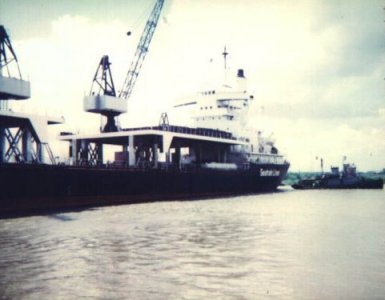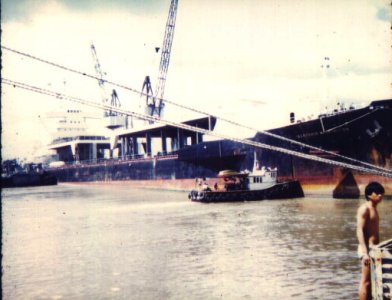

T2 Tanker Conversion and a Sea Story
Here are a couple more photos courtesy of Mr. Hayden, as well as a sea story.


Mr. Hayden explains:
"Seatrain Washington -- sister ship to the Seatrain Maine. They were taken at Newport -- the docks the US built up-river from Saigon.
As an aside -- I was in there when Lyndon Johnson was over on an 'inspectin trip' -- while he was Pres -- we saw this HUGE sea of uniformed men walk along the pier and were assured that 'somewhere' in that crowd was LBJ.
Anyway, they were converted from the 10,000HP models of T2's called 'Missions' because each was named after a California Mission.
Ya can see the 'flight decks' some thirty feet above the main decks. The cargo gear was two - 270 ton La Tourneau (sp?) cranes. They were converted in the early fifties and carried railroad cars between New Jersey and Cuba. There were five sets of railroad tracks on the main deck and three pairs in the lower and on the 'tween decks. On the main deck one set each was 'outboard' of the 'flight deck' stanchions or columns. The 'flight decks' were used to carry 'trailer trucks' in the early days.
There were five of these vessels that had been layed up since around 1959 when this bearded fellow took over in Cuba. When 'Nam began to 'heat up' they were again 'converted' to 'Fueled Vehicle Carriers'. We carried anything with wheels fully fueled and, in the case of aircraft - often - 'armed'. The conversion entailed installing 'enough' CO2 to completely 'flood' the cargo hold. There were these red 200 # CO2 cylinders 'everywhere'.
There were two in the back of my closet -- and six more in my cabin. They lined the passageways -- they were 'everywhere'. All manifolded together. The cargo hold was this big huge space. NO WT bulkheads between the foreward and aft end. The cargo hold was lit with HP Sodium lights, and, being painted 'aluminum' could be 'well' lit.
When the US Marines 'landed' in DaNang -- all five of these vessels were employed. There were Huey's -- with their 'blades' furled -- and LCM's in the lower and 'tween. There were 'more' Huey's on parts of the flight decks -- and there were two Helicopter LZ's painted up there. On the main deck were these 'personnel' containers. All the ship hadda supply was sea water off'n the fireline -- and power. There were 'waste' overboards dangling down both sides of the ship. They had galley containers and 'dining room' containers and bunk containers and office containers and 'head' and shower containers.
When I sailed the Maine each trip we carried a dozen F5's on the flight deck. These aircraft were fully fueled and armed and 'wrapped' in these 'peel off' white plastic shrouds. Seems that our great Unca Sam was 'giving' these to South Korea -- but the Koreans would NOT accept them until they FLEW them.
So when shipped on a conventional ship -- the ship hadda hang around literally weeks while the aircraft were fixed up ready to fly -- and flown -- before they could leave.
We'd 'anchor' off the end of this runway around the corner from Pusan ... and kinda 'drift' up alongside until we hit the edge of the channel -- then crane these F5's onto the end of the runway. The plastic would be torn off -- the aircraft 'pre-flighted' then flown. We could get rid of a dozen in a day -- and be gone.
We carried these huge banana shaped helicopters -- with their rotors off. We'd discharge them at a pier -- the army guys would fit the blades -- and fly them away from the pier.
Oh, take a look at the 'after castle' on these ships. What they did when they originally converted them -- was build a 'splice' piece about twenty feet high atop the T2 after house -- then just pick up the original mid ship house and set it atop the 'splice' piece. This 'splice' piece was a HUGE storeroom for the engine department. There were HUGE barn like water tight doors that opened onto the aft end of the aft flight deck.
The distance from the deck of the bridge wings to the water fully loaded was 110 feet!!!
Towards the 'end' of 'Nam, when the PBR's were being 'handed' over to the Vietnamese -- we hadda 'interesting' thing occur. There was this one Army Sergeant that the C/E had met on previous trips. This particular trip he told us his sad tale of woe. He was based in Qui Knohn (sp?) and responsibe for four PBR's. He hadda get them to DaNang, turn them over to the Viets -- then he and his crews could 'go home'.
But they could NOT get any 'priority' to get these boats shipped to DaNang. So the C/E agreed to 'transport' them. We loaded them into our engine room storeroom in the 'splice piece' -- all four fit with no problem.
The skipper 'knew' nothing about it until we were outta there and headed up the coast. When he came down for dinner he found FIVE 'strange' US Army Sergeants sitting at the saloon table -- and there were another 26 guys over in the crews mess.
To say the olde man was 'pissed' puts it mildly. ESPECIALLY when we got this 'stop and wait for a 'possible' diversion to Manila' message. Ooops!
We lay out there fully 24 hours just drifting around waiting. Lotsa folks worried a lot during that time. But, finally, we were radioed to 'forget it' an proceed to DaNang.
Whew!!!
OBTW -- this Seargeant 'paid' by 'giving' the C/E and me - 1 A/E - each a M-16 with 500 rounds and an AK-47 with 500 rounds.
I was 'nervous' about this. And just left them lie around my cabin all the way back. The C/E on the other hand 'built' two plywood cases -- HEAVY cases with the 500 rounds -- then covered them with sewn canvas. A day outta the states I tossed all mine overboard. The C/E did NOT declare these things. He just 'stashed' them up there in the ER storeroom in the 'splice' section.
We 'cleared' in San Francisco -- then went down to San Diego to pick up cargo for the next voyage. Bold as brass the C/E went walking up the street to the Greyhound Bus Depot to ship these things home. When he walked in the bus depot this 'guy' comes up to him and asks him 'whatcha got there fella?' and without thinking about it he says 'chess sets' -- so this guy 'tags' along and when the clerk weighs these things and finds out how heavy they are this guy remarks -- 'damn heavy chess sets' and the C/E says 'brass chess sets'.
So -- sweating all the way he walks back to the ship. When we get back to SF he gets off on vacation. When he gets home -- an 'island' off the coast of Maine -- he waits a few days -- then takes a walk down to the local bus depot / cafe and looks around. He see's this 'unmarked' Ford with US Govt. license plates just sitting outside with two huge guys sitting in it. So he checks everyday and everyday the Ford is there.
Finally, after about a week and the Ford is still there -- he goes into the bus depot luggage area from the 'backway' -- a door from an adjacent business that faces another street. He just picks these things up and scrams. He sweats it all the way home.
Then stay's away from the bus depot.
So a couple months later he decides to go out 'shining deer' in the island forest. He straps a five cell flashlight beneath the barrel of the M-16 -- and when he 'freezes' a deer pulls the trigger -- and set on 'full auto' rips off a long pull -- of 'mostly' bright red 'tracers' -- and the weapon 'climbs' so he's shooting into the air.
Uh-oh.
Yup. Townspeople 'saw' it and people pour out onto the street.
Like a scene in 'The Russians are coming'.
So he quick like a bunny 'sneaks' home, gathers up all this stuff and dumps it in the trunk of his car -- and heads down to the town pier and drives out on it and turns around at the far end and dumps all this crap off the pier.
Then 'innocently' joins the townspeople on the streets asking?
'What's happening?'"
 Click here to return to The T2 Tanker Page
Click here to return to The T2 Tanker Page